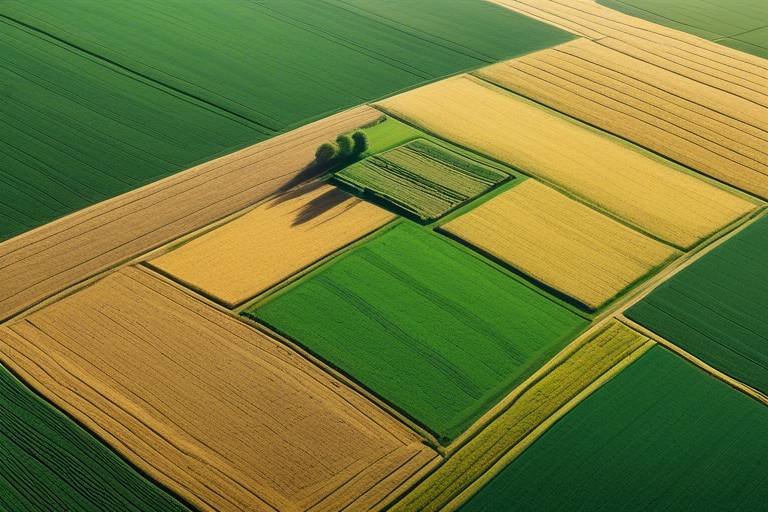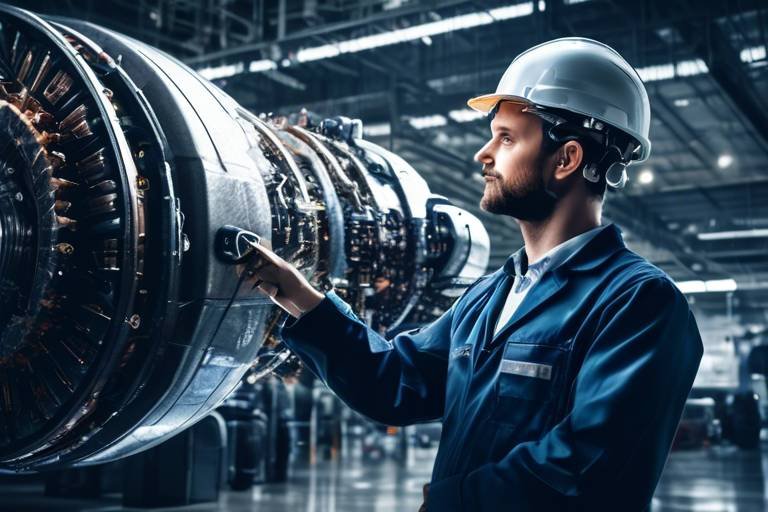AI in Agriculture: The Key to Boosting Farm Productivity
In a world where food demand is skyrocketing and traditional farming methods are struggling to keep pace, artificial intelligence (AI) emerges as a beacon of hope. Imagine a farmer standing in the middle of a vast field, equipped not just with tools, but with a digital assistant that can analyze data, predict weather patterns, and even monitor the health of crops in real-time. This isn't science fiction; it's the reality of modern agriculture. From optimizing resource usage to enhancing crop yields, AI is revolutionizing the farming landscape, making it more efficient and sustainable.
But what does this transformation look like on the ground? Picture a farm where drones fly overhead, capturing high-resolution images of crops, while sensors in the soil provide feedback on moisture levels. This data is then processed by AI algorithms that offer actionable insights to farmers, enabling them to make informed decisions that boost productivity. With AI, farming is no longer just about hard work; it’s about smart work.
The integration of AI into agriculture is not just a trend; it’s a game-changer. By harnessing the power of AI, farmers can tackle some of the most pressing challenges they face today, such as climate change, labor shortages, and the need for sustainable practices. For instance, AI can help in predicting pest outbreaks before they become a significant threat, allowing for timely interventions that save both crops and resources.
Moreover, the benefits of AI extend beyond the farm itself. As farmers increase their productivity, they contribute to food security on a global scale. With the world population projected to reach nearly 10 billion by 2050, the pressure on agriculture to produce more food is immense. AI provides the tools necessary to meet this challenge head-on, ensuring that we can feed the growing population while also protecting our planet.
In summary, AI is not just enhancing farm productivity; it is reshaping the entire agricultural sector. As we delve deeper into the various applications of AI in farming, we will uncover how this technology is paving the way for a more efficient, sustainable, and productive future in agriculture.

Understanding AI in Agriculture
Artificial Intelligence (AI) is not just a buzzword; it’s a transformative force that’s reshaping the agricultural landscape. At its core, AI refers to the simulation of human intelligence in machines that are programmed to think and learn like humans. In agriculture, this means leveraging technology to solve complex problems, improve efficiency, and enhance overall productivity. Imagine a world where farmers can predict weather patterns, monitor crop health in real-time, and optimize resource use—all from the comfort of their smartphones. This is the promise of AI in agriculture.
So, what are the key components of AI that are making waves in farming? First, we have machine learning, which allows systems to learn from data and improve over time without being explicitly programmed. Then there’s computer vision, enabling machines to interpret and understand visual information from the world, such as identifying diseases in crops. Lastly, we have data analytics, which processes vast amounts of data to provide actionable insights. Together, these components are revolutionizing traditional farming practices, making them more efficient and sustainable.
As we delve deeper into how AI applies specifically to agriculture, it's essential to recognize the challenges farmers face today. From unpredictable weather conditions to pest infestations and labor shortages, the agricultural sector is under constant pressure to produce more with less. Here’s where AI steps in as a game-changer. By automating routine tasks and providing data-driven insights, AI empowers farmers to make informed decisions that can significantly enhance their productivity.
For instance, consider the role of AI in predicting crop yields. By analyzing historical data and current environmental conditions, AI algorithms can forecast how much produce a farmer can expect, allowing them to plan better and allocate resources efficiently. This level of precision not only helps in maximizing profits but also contributes to sustainability by minimizing waste.
Moreover, the integration of AI in agriculture is not just about improving yields; it’s about creating a more resilient agricultural system. With climate change posing a significant threat to food security, AI can help farmers adapt to changing conditions. For example, AI systems can analyze weather data to suggest optimal planting times or recommend crop varieties that are more resistant to droughts or floods.
In summary, understanding AI in agriculture involves recognizing its potential to transform farming practices fundamentally. By embracing AI technologies, farmers can overcome challenges, enhance productivity, and contribute to a more sustainable future for food production. The journey has just begun, and as technology continues to evolve, the possibilities for AI in agriculture are virtually limitless.

Applications of AI in Farming
Artificial Intelligence is not just a buzzword; it's a game changer in the agricultural landscape. Imagine walking through a farm where every inch of land is monitored, every crop is cared for with precision, and every decision is backed by data. This is the reality that AI is creating in farming today. The applications of AI in agriculture are as diverse as they are impactful, fundamentally transforming how farmers operate and manage their crops.
One of the most significant applications of AI is in precision agriculture. This approach uses AI algorithms to analyze vast amounts of data collected from various sources, including satellite imagery, drones, and sensors placed in the fields. By understanding the unique conditions of different parts of a farm, farmers can optimize their practices, ensuring that resources like water, fertilizers, and pesticides are used efficiently. This not only leads to improved yields but also minimizes environmental impact.
Precision agriculture is like having a personal coach for your crops. It tailors farming practices to the specific needs of each plant, based on real-time data. This means farmers can apply the right amount of water or nutrients exactly when and where they are needed. For instance, with AI-driven data analysis, farmers can identify which sections of their fields are underperforming and adjust their strategies accordingly. The result? A more sustainable farming operation that can produce more with less.
Imagine being able to make decisions based on solid data rather than guesswork. AI empowers farmers to do just that. By harnessing data analytics, farmers can gain insights into weather patterns, soil conditions, and crop health. This enables them to make informed decisions that enhance productivity and sustainability. For example, if AI detects that a specific area of a field is prone to drought, farmers can proactively adjust their irrigation strategies to conserve water while maximizing crop health.
Water is a precious resource, and AI is helping farmers use it wisely through automated irrigation systems. These systems leverage AI to determine the optimal watering schedule based on real-time data such as soil moisture levels and weather forecasts. By ensuring that crops receive the right amount of water at the right time, farmers can conserve resources and improve the overall health of their crops. This not only leads to better yields but also contributes to environmental sustainability.
Another exciting application of AI is in crop health monitoring. With the help of AI technologies, farmers can monitor their crops in real-time, detecting diseases and pests at an early stage. This proactive approach allows for timely interventions, significantly reducing crop losses. For instance, drones equipped with AI can scan fields and identify areas where plants are stressed or infected. Farmers can then target those areas with specific treatments, rather than spraying pesticides indiscriminately across the entire field.
The integration of AI in farming is not just about enhancing productivity; it's about creating a more efficient and sustainable agricultural system. As technology continues to evolve, the possibilities for AI applications in farming are endless. From optimizing planting schedules to predicting market trends, AI is set to revolutionize how we grow food and manage resources.
- What are the main benefits of using AI in agriculture? AI enhances efficiency, reduces labor costs, improves crop yields, and promotes sustainable farming practices.
- How does precision agriculture work? Precision agriculture uses data analytics and AI to optimize farming practices tailored to specific areas of a field.
- Can small-scale farmers afford AI technology? While initial costs can be high, there are increasingly affordable solutions and support programs available for small-scale farmers.
- What role does AI play in crop health monitoring? AI technologies enable real-time monitoring of crops, allowing for early detection of diseases and pests.

Precision Agriculture
Precision agriculture is like having a superpower for farmers, allowing them to see and understand their fields in ways that were once unimaginable. Imagine walking through a vast expanse of crops, but instead of just looking at the plants, you have a detailed map of their health, nutrient levels, and water needs right at your fingertips. This is the magic of AI technology in farming. By utilizing advanced data analytics, farmers can optimize their practices to ensure that every seed planted has the best chance of thriving.
At the heart of precision agriculture is the collection and analysis of vast amounts of data. Sensors, drones, and satellite imagery work together to gather information about soil conditions, weather patterns, and crop health. This data is then processed using AI algorithms that can identify patterns and make predictions. For instance, farmers can determine the optimal time for planting or harvesting based on real-time environmental conditions. This level of insight not only enhances productivity but also minimizes waste—making farming more sustainable.
One of the most significant advantages of precision agriculture is its ability to promote efficient resource use. Farmers can apply fertilizers and pesticides only where they are needed, rather than blanket applying them across the entire field. This targeted approach reduces the overall amount of chemicals used, which is not only better for the environment but also cuts down on costs. Additionally, precision irrigation systems can ensure that crops receive the right amount of water at the right time, conserving this precious resource.
To illustrate the impact of precision agriculture, consider the following table that highlights some key benefits:
| Benefit | Description |
|---|---|
| Resource Efficiency | Minimizes waste of water, fertilizers, and pesticides. |
| Higher Yields | Improves crop production through targeted interventions. |
| Sustainability | Reduces environmental impact, promoting healthier ecosystems. |
In essence, precision agriculture is transforming traditional farming into a high-tech operation where data drives decisions. It's not just about making things easier; it's about making them smarter. Farmers who embrace this technology are not only enhancing their productivity but also contributing to a more sustainable future for agriculture. As we move forward, the integration of AI in farming will continue to evolve, unlocking new possibilities and solutions to age-old challenges.
- What is precision agriculture? Precision agriculture refers to the use of technology and data analytics to optimize farming practices, ensuring efficient resource use and higher crop yields.
- How does AI improve farming? AI improves farming by analyzing data to provide insights that help farmers make informed decisions about planting, irrigation, and pest control.
- Is precision agriculture expensive? While the initial investment can be high, the long-term savings and increased productivity often outweigh these costs.
- Can small-scale farmers benefit from precision agriculture? Yes, with the right tools and training, small-scale farmers can also leverage precision agriculture to improve their yields and reduce costs.

Data-Driven Decision Making
In the ever-evolving world of agriculture, is becoming a game-changer for farmers. Imagine being able to predict the best time to plant your crops or knowing exactly how much fertilizer to apply to maximize yields. With the power of artificial intelligence (AI), this is not just a dream but a reality that is reshaping the agricultural landscape.
Farmers today are armed with a plethora of data—from weather patterns to soil health metrics—that can significantly influence their farming strategies. By utilizing AI algorithms, they can analyze vast amounts of data quickly and accurately, leading to informed decisions that enhance productivity and sustainability. For instance, AI can process historical yield data alongside current environmental conditions to forecast potential outcomes. This allows farmers to adjust their practices proactively rather than reactively, which is crucial in a field where timing can make or break a harvest.
Moreover, the integration of AI in data analysis enables farmers to identify trends and patterns that might not be immediately apparent. For example, by examining data on pest populations and their correlation with weather changes, farmers can anticipate pest outbreaks and take preventive measures. This not only saves time and resources but also minimizes the reliance on chemical pesticides, promoting a healthier ecosystem.
To illustrate the impact of data-driven decision making, consider the following table that summarizes key benefits:
| Benefit | Description |
|---|---|
| Increased Efficiency | Optimizes resource allocation by analyzing data to determine the best practices. |
| Enhanced Yield Predictions | Utilizes historical data to forecast crop yields, allowing for better planning. |
| Proactive Pest Management | Identifies potential pest threats early through data analysis, enabling timely interventions. |
| Resource Conservation | Reduces waste by ensuring that inputs like water and fertilizers are used efficiently. |
In addition to these benefits, the shift towards data-driven decision making fosters a culture of continuous improvement in farming practices. Farmers are encouraged to experiment and innovate, using data as a compass to navigate the complexities of modern agriculture. This not only enhances their operational efficiency but also contributes to the overall sustainability of the agricultural sector.
However, it’s important to note that the success of data-driven decision making hinges on the accessibility and usability of data. Farmers need to be equipped with the right tools and training to interpret data effectively. This underscores the importance of educational programs that can help bridge the gap between technology and traditional farming practices.
- What is data-driven decision making in agriculture? It refers to the use of data analysis and AI to inform farming practices and optimize productivity.
- How does AI improve farming? AI enhances farming by providing insights that lead to better resource management, yield predictions, and pest control.
- What challenges do farmers face with data-driven decision making? Farmers may encounter challenges such as high implementation costs and the need for technical training.

Automated Irrigation Systems
Imagine a world where farmers no longer have to worry about whether their crops are getting enough water. are making this dream a reality, revolutionizing the way water is managed on farms. These systems utilize artificial intelligence to monitor soil moisture levels, weather forecasts, and even crop needs, ensuring that every drop of water is used efficiently. By integrating sensors and advanced algorithms, farmers can now automate the irrigation process, significantly reducing water wastage and promoting healthier crops.
The beauty of automated irrigation lies in its precision. Traditional irrigation methods often lead to overwatering or underwatering, which can stress plants and lead to poor yields. In contrast, AI-powered systems can assess the specific needs of different crops at various growth stages. For instance, during a hot spell, a sensor might detect that the soil is drying out faster than usual. The system can then automatically adjust the water supply, ensuring that the plants get just the right amount of hydration they need to thrive. This level of control not only enhances crop health but also conserves precious water resources, making farming more sustainable.
Moreover, automated irrigation systems can be integrated with weather data. By analyzing forecasted rainfall and temperature changes, these systems can preemptively adjust irrigation schedules. If rain is expected, the system can temporarily halt watering, preventing unnecessary water usage. This smart adaptation to environmental conditions is a game-changer for farmers, allowing them to be proactive rather than reactive.
To illustrate the effectiveness of these systems, consider the following table that compares traditional irrigation methods with automated systems:
| Feature | Traditional Irrigation | Automated Irrigation |
|---|---|---|
| Water Efficiency | Low | High |
| Labor Requirements | High | Low |
| Crop Health Monitoring | No | Yes |
| Response to Weather Changes | Manual | Automatic |
In addition to enhancing efficiency and productivity, automated irrigation systems also contribute to cost savings. By reducing water usage and labor costs associated with manual irrigation, farmers can allocate their resources more effectively. This cost-effectiveness is especially crucial for small-scale farmers who may operate on tight budgets. As a result, the adoption of these systems not only boosts productivity but also enhances the overall economic viability of farming operations.
However, it's essential to acknowledge that the transition to automated irrigation systems does require an initial investment. Farmers need to consider the costs associated with purchasing and installing these advanced technologies. Yet, the long-term benefits often outweigh the initial financial burden, making it a worthwhile investment in the future of agriculture.
In conclusion, automated irrigation systems represent a significant leap forward in agricultural technology. By harnessing the power of artificial intelligence, farmers can optimize their water usage, improve crop health, and ultimately increase their yields. As we move towards a more sustainable future, embracing these innovations is not just an option; it's a necessity for the survival and prosperity of farming.
- What are automated irrigation systems?
Automated irrigation systems use technology and sensors to manage the watering of crops efficiently, ensuring optimal water usage based on real-time data. - How do these systems improve water efficiency?
By monitoring soil moisture and weather conditions, automated systems can adjust watering schedules, preventing overwatering and conserving water resources. - Are automated irrigation systems expensive?
While the initial investment can be high, the long-term savings on water and labor costs often make them a financially viable option for farmers. - Can small-scale farmers benefit from automated irrigation?
Absolutely! These systems can be tailored to fit the needs and budgets of small-scale operations, enhancing productivity and sustainability.

Crop Health Monitoring
In the ever-evolving world of agriculture, has emerged as a game-changer, harnessing the power of artificial intelligence to ensure that farmers can keep a close eye on their fields. Imagine walking through a vast expanse of crops, and instead of relying solely on your instincts and experience, you have a digital assistant that analyzes every leaf, every stem, and every inch of soil. This is the reality that AI brings to the table, allowing farmers to detect issues before they escalate into significant problems.
With the integration of AI technologies, farmers can utilize real-time data to monitor the health of their crops effectively. This involves using various tools such as drones, satellite imagery, and ground sensors that collect data on factors like soil moisture, temperature, and plant health. For instance, drones equipped with advanced imaging technology can fly over fields, capturing high-resolution images that reveal the condition of crops. This enables farmers to identify areas that might be suffering from disease or pest infestations, allowing for timely interventions that can save entire harvests.
The benefits of AI-driven crop health monitoring extend beyond just early detection. By analyzing historical data alongside real-time inputs, AI can provide insights into patterns and trends that may not be immediately obvious to the naked eye. This data-driven approach empowers farmers to make informed decisions, optimizing their use of resources and minimizing waste. For example, if a specific crop variety is consistently affected by a particular disease, farmers can adapt their planting strategies to include more resistant varieties, thus enhancing overall productivity.
Moreover, the implementation of AI in crop health monitoring allows for a more sustainable approach to farming. By pinpointing exactly where interventions are needed, farmers can apply pesticides or fertilizers more judiciously, reducing chemical runoff into the environment. This not only helps in maintaining soil health but also aligns with the growing consumer demand for sustainable agricultural practices.
In summary, AI-enabled crop health monitoring is revolutionizing how farmers manage their fields. It provides them with the tools to detect problems early, make informed decisions, and adopt sustainable practices. As technology continues to advance, the future of crop health monitoring looks promising, offering even more sophisticated solutions that will further enhance agricultural productivity.
- What is crop health monitoring?
Crop health monitoring refers to the use of technology, particularly AI, to assess and manage the health of crops through real-time data collection and analysis. - How does AI improve crop health monitoring?
AI improves crop health monitoring by analyzing large datasets from various sources, such as drones and sensors, to detect issues like diseases and pests early. - Can small-scale farmers benefit from AI technologies?
Yes, while there may be initial costs, small-scale farmers can significantly benefit from AI technologies by increasing efficiency and crop yields. - What are the environmental benefits of AI in agriculture?
AI helps reduce the use of chemicals by allowing for targeted applications, which minimizes runoff and promotes sustainable farming practices.

Benefits of AI in Agriculture
Artificial Intelligence (AI) is not just a buzzword; it’s a game-changer in the world of agriculture. By integrating AI technologies, farmers can experience a myriad of benefits that enhance productivity and sustainability. Imagine having a tool that not only helps you understand your land better but also predicts the best times to plant and harvest. This is the power of AI.
One of the most significant advantages of AI in agriculture is increased efficiency. Traditional farming methods often rely on guesswork and outdated practices. However, with AI, farmers can utilize data-driven insights to make informed decisions. For instance, AI algorithms analyze weather patterns, soil conditions, and crop health, allowing farmers to optimize their operations. This leads to better resource management and ultimately, higher yields.
Furthermore, AI can significantly reduce labor costs. By automating various tasks such as planting, watering, and harvesting, farmers can minimize the need for manual labor. This not only saves money but also allows farmers to allocate their workforce to more critical areas of their operations. For example, AI-powered drones can monitor large fields more efficiently than human workers, providing real-time data that is crucial for making timely decisions.
Another remarkable benefit is the potential for improved crop yields. With AI technologies, farmers can monitor their crops more closely than ever before. AI systems can detect early signs of diseases or pest infestations, enabling farmers to act quickly and prevent significant losses. This proactive approach to crop management is essential, especially as the global population continues to grow and the demand for food increases.
To illustrate the impact of AI on crop yields, consider the following table:
| Year | Traditional Yield (tonnes/hectare) | AI-Enhanced Yield (tonnes/hectare) |
|---|---|---|
| 2019 | 2.5 | 3.5 |
| 2020 | 2.7 | 4.0 |
| 2021 | 2.9 | 4.5 |
This table clearly shows how AI can enhance yields over time, illustrating the potential for farmers to produce more with less. As technology continues to evolve, we can expect these numbers to rise even further.
Moreover, AI contributes to sustainability in agriculture. By optimizing resource use—such as water and fertilizers—farmers can reduce waste and minimize their environmental footprint. For instance, AI-driven irrigation systems ensure that crops receive just the right amount of water, conserving this precious resource while promoting healthier plants.
In summary, the benefits of AI in agriculture are profound and wide-ranging. From cost reduction to improved crop management and sustainability, AI is paving the way for a more efficient and productive agricultural sector. As we move forward, embracing these technologies will be crucial for farmers looking to thrive in a rapidly changing landscape.
- How does AI improve crop monitoring? AI utilizes sensors and data analytics to provide real-time information about crop health, enabling early detection of issues.
- What are the initial costs of implementing AI in agriculture? While initial costs can be high, the long-term savings and productivity increases often justify the investment.
- Can small-scale farmers benefit from AI? Absolutely! There are scalable AI solutions tailored for small-scale operations that can significantly enhance efficiency and yield.

Cost Reduction
One of the most compelling reasons farmers are embracing artificial intelligence is the potential for significant . In an industry where margins can be razor-thin, every dollar saved counts. AI technologies streamline various farming processes, allowing farmers to operate more efficiently and effectively. For instance, by utilizing AI-driven analytics, farmers can optimize their use of fertilizers and pesticides, applying them only when necessary and in the right amounts. This not only saves money but also minimizes environmental impact.
Moreover, AI can automate tasks that traditionally required extensive labor. Think about it: instead of hiring multiple workers for manual tasks, a farmer might deploy automated systems powered by AI to handle everything from planting to harvesting. This shift not only reduces labor costs but also mitigates the risks associated with labor shortages, which can be a significant concern during peak seasons.
To illustrate the impact of AI on cost reduction, consider the following table that compares traditional farming costs with those utilizing AI technologies:
| Cost Factor | Traditional Farming | AI-Enhanced Farming |
|---|---|---|
| Labor Costs | High | Reduced |
| Resource Usage (Water, Fertilizers) | Excessive | Optimized |
| Yield Variability | High | Minimized |
| Overall Operational Costs | High | Lowered |
Additionally, AI systems can predict market trends and crop prices, allowing farmers to make informed decisions about what to plant and when to sell. This foresight can lead to better financial planning and reduced risk of loss. Imagine a farmer who can forecast the best time to sell their produce based on market data; this capability not only maximizes profits but also ensures that they are not left with unsold stock.
In summary, the integration of AI in agriculture is not merely a trend; it represents a fundamental shift towards a more sustainable and cost-effective approach to farming. As these technologies continue to evolve, we can expect even greater efficiencies and savings, ultimately leading to a more resilient agricultural sector.
- How does AI reduce costs in agriculture? AI reduces costs by automating tasks, optimizing resource use, and providing data-driven insights for better decision-making.
- Are AI technologies expensive to implement? While the initial investment can be high, the long-term savings and increased efficiency often outweigh the costs.
- What types of AI tools are available for farmers? There are various AI tools available, including crop monitoring systems, automated irrigation solutions, and data analytics platforms.
- Can small-scale farmers benefit from AI? Yes, small-scale farmers can benefit from AI by accessing affordable technologies and training programs designed for their needs.

Improved Crop Yields
When it comes to farming, the ultimate goal is clear: maximize crop yields. With the integration of artificial intelligence in agriculture, this goal is becoming more achievable than ever. AI technologies are revolutionizing how farmers monitor and manage their crops, leading to substantial increases in productivity. Imagine a world where every seed planted is nurtured with precision, where data-driven insights guide every decision. This is not just a dream; it’s the reality that AI is creating in the agricultural sector.
One of the most significant ways AI contributes to improved crop yields is through enhanced monitoring. Farmers can now utilize AI-powered tools that analyze vast amounts of data collected from the field. This includes soil health, moisture levels, and nutrient content. By understanding these factors in real-time, farmers can make informed decisions that directly affect the health and productivity of their crops. For instance, using AI algorithms, they can determine the optimal time for planting, watering, and harvesting, ensuring that crops receive exactly what they need when they need it.
Moreover, AI enables farmers to predict outcomes with greater accuracy. Through machine learning models, historical data can be analyzed to forecast crop performance under various conditions. This predictive capability allows farmers to anticipate challenges such as droughts or pest infestations, enabling them to take proactive measures. For example, if a particular crop variety is known to thrive in specific weather conditions, farmers can adjust their planting strategies accordingly, leading to higher yields.
Additionally, AI facilitates precision agriculture, which is all about using technology to apply the right amount of inputs at the right time. This means that fertilizers and pesticides can be applied more efficiently, reducing waste and ensuring that crops receive the nutrients they need for optimal growth. By minimizing the use of chemicals and maximizing their effectiveness, farmers not only enhance yields but also contribute to a more sustainable farming practice.
To illustrate the impact of AI on crop yields, consider the following table that summarizes key benefits:
| Benefit | Description |
|---|---|
| Real-Time Monitoring | Continuous observation of crop health and environmental conditions. |
| Predictive Analytics | Forecasting crop performance and potential challenges. |
| Resource Optimization | Efficient use of water, fertilizers, and pesticides. |
| Sustainability | Reducing environmental impact while increasing yields. |
In conclusion, the integration of AI in agriculture is not just a trend; it’s a transformative shift that is paving the way for improved crop yields. By leveraging data and technology, farmers can optimize their practices, reduce waste, and ultimately produce more food to meet the growing global demand. As we continue to embrace these innovations, the future of farming looks brighter than ever, filled with opportunities for growth and sustainability.
- How does AI improve crop yields? AI enhances crop yields by providing real-time monitoring, predictive analytics, and resource optimization, allowing farmers to make informed decisions.
- What are the main benefits of precision agriculture? The main benefits include increased efficiency, reduced waste, and improved sustainability, all contributing to higher crop yields.
- Is AI technology expensive for farmers? While the initial investment can be high, the long-term benefits and cost savings often outweigh the initial costs.
- Do farmers need training to use AI tools? Yes, proper training is essential for farmers to effectively utilize AI technologies and maximize their benefits.

Challenges and Considerations
While the integration of AI in agriculture offers numerous advantages, it is not without its challenges. One of the most significant hurdles is the high implementation costs associated with adopting new technologies. For many small-scale farmers, the financial burden of investing in AI tools can be daunting. These costs include not only the initial purchase of hardware and software but also ongoing maintenance and updates. This situation can create a divide between larger agricultural enterprises that can absorb these expenses and smaller farms that struggle to keep up.
Moreover, the need for technical training cannot be overstated. Farmers must be equipped with the skills to effectively utilize AI technologies. This means that educational programs and resources are essential to bridge the knowledge gap. Without proper training, farmers may find themselves overwhelmed by the complexities of AI tools, leading to underutilization or even misuse of the technology. Institutions and organizations must step up to provide support and resources to ensure that farmers can harness the full potential of AI.
Another consideration is the data privacy and security concerns that come with the use of AI in agriculture. With the reliance on data-driven insights, farmers must be cautious about how their data is collected, stored, and used. Ensuring robust cybersecurity measures are in place is crucial to protect sensitive information from potential breaches. Additionally, farmers should be aware of the implications of sharing their data with third-party companies and how it may affect their operations.
Lastly, there is a growing concern about the impact of AI on employment within the agricultural sector. As automation becomes more prevalent, there is a fear that traditional farming jobs may be at risk. While AI can enhance productivity and efficiency, it is essential to find a balance that ensures workers are not left behind. The industry must focus on creating new opportunities that complement AI technologies rather than replace human labor entirely.
In summary, while the potential of AI in agriculture is immense, addressing these challenges is crucial for its successful implementation. Stakeholders must work together to develop solutions that make AI accessible, secure, and beneficial for all farmers, regardless of their size or resources.
- What are the main challenges of implementing AI in agriculture?
The main challenges include high implementation costs, the need for technical training, data privacy concerns, and potential impacts on employment. - How can small-scale farmers afford AI technology?
Small-scale farmers can seek grants, subsidies, or cooperative models to share the costs of AI technology. - What types of training are needed for farmers to use AI?
Training should focus on data analysis, software usage, and understanding AI tools to enhance productivity and efficiency. - How can farmers ensure their data is secure?
Farmers can implement strong cybersecurity practices and carefully review data-sharing agreements with third-party providers.

High Implementation Costs
When it comes to adopting artificial intelligence in agriculture, one of the most significant hurdles farmers face is the . These expenses can be daunting, particularly for small-scale farmers who often operate on tight budgets. The initial investment required to integrate AI technology into farming practices can include costs for hardware, software, and ongoing maintenance, which can quickly add up. For instance, a farmer may need to invest in advanced sensors, drones, and data analytics platforms, all of which contribute to a hefty price tag.
Moreover, the costs don't stop at the technology itself. Farmers also need to consider the expenses associated with training and support. Understanding how to effectively utilize AI tools requires time and effort, which translates to additional costs. This situation can create a significant barrier to entry for those who may not have the financial resources readily available.
To illustrate the financial implications, consider the following table that breaks down some of the common costs associated with implementing AI in agriculture:
| Item | Estimated Cost |
|---|---|
| Advanced Sensors | $5,000 - $15,000 |
| Drones for Monitoring | $1,000 - $20,000 |
| Data Analytics Software | $2,000 - $10,000 |
| Training Programs | $500 - $5,000 |
As you can see, the initial costs can be quite substantial. It's no wonder that many farmers hesitate to embrace these innovations when faced with such financial burdens. However, it’s essential to recognize that while the upfront costs are high, the long-term benefits of implementing AI can often outweigh these initial investments. Farmers who successfully navigate these challenges may find themselves enjoying improved efficiency, reduced labor costs, and ultimately, enhanced profitability.
In conclusion, while the high implementation costs of AI in agriculture pose a significant challenge, they are not insurmountable. With the right support, resources, and a clear understanding of the potential return on investment, farmers can make informed decisions about integrating AI into their practices. The key lies in balancing the initial financial outlay with the long-term gains that AI technology can offer.
- What are the main costs associated with AI in agriculture? The main costs include hardware, software, training, and maintenance.
- Can small-scale farmers afford AI technology? While the initial costs can be high, there are financing options and support programs available to assist small-scale farmers.
- What are the long-term benefits of implementing AI? Long-term benefits include increased efficiency, reduced labor costs, and improved crop yields.

Need for Technical Training
As we dive deeper into the realm of artificial intelligence in agriculture, one critical aspect that cannot be overlooked is the . While AI technologies promise to revolutionize farming practices, their successful implementation hinges on the farmers' ability to effectively utilize these tools. Imagine trying to navigate a high-tech spaceship without any training—it's not just daunting; it's nearly impossible! Similarly, farmers who are not equipped with the necessary skills may find themselves at a disadvantage.
Technical training is essential for several reasons:
- Understanding AI Tools: Farmers need to grasp how AI applications work. This includes everything from understanding data analytics to operating automated machinery. Without this knowledge, the potential of AI can be significantly underutilized.
- Maximizing Benefits: Proper training ensures that farmers can fully leverage AI capabilities to enhance productivity and sustainability. When farmers know how to interpret data and act on it, they can make informed decisions that lead to better crop management.
- Adaptation to Change: The agricultural landscape is ever-evolving, and with the introduction of AI, farmers must adapt to new methodologies. Training programs can help ease this transition, making it less intimidating.
Moreover, the implementation of technical training programs can take various forms. Workshops, online courses, and on-field training sessions can be tailored to meet the specific needs of farmers. These programs should focus on:
| Training Type | Description |
|---|---|
| Workshops | Hands-on sessions where farmers can learn about AI tools in a practical setting. |
| Online Courses | Flexible learning options that allow farmers to study at their own pace, covering topics like data analysis and machine operation. |
| On-field Training | Direct application of AI tools in the field, guided by experts, to ensure farmers gain practical experience. |
In conclusion, the integration of AI into agriculture is not just about the technology itself; it's also about empowering farmers with the knowledge and skills they need to harness its full potential. As we look towards a future where AI plays a pivotal role in farming, investing in technical training is not merely an option—it is a necessity. By fostering a culture of continuous learning, we can ensure that farmers are not left behind in this technological revolution, ultimately leading to a more sustainable and productive agricultural sector.
1. Why is technical training important for farmers using AI?
Technical training is crucial because it equips farmers with the skills needed to effectively use AI tools, ensuring they can maximize the benefits of these technologies in their farming practices.
2. What types of training programs are available for farmers?
Farmers can access various training programs, including workshops, online courses, and on-field training sessions, each designed to address different aspects of AI technology in agriculture.
3. How can farmers find training opportunities?
Farmers can look for training opportunities through agricultural extension services, local universities, and online platforms that specialize in agricultural education.
4. What challenges do farmers face in accessing technical training?
Some challenges include high costs, lack of awareness about available programs, and the need for flexible training schedules that accommodate the farmers’ busy routines.

The Future of AI in Agriculture
The future of AI in agriculture is not just promising; it's downright exciting! As we stand on the brink of a technological revolution, the integration of AI into farming practices is set to redefine how we grow food, manage resources, and tackle the challenges of climate change. Imagine a world where farmers can predict crop yields with pinpoint accuracy, or where drones equipped with AI can monitor fields in real-time, identifying issues before they escalate. This isn’t science fiction; it’s the future of agriculture.
One of the most significant advancements we can expect is in the realm of machine learning. By harnessing vast amounts of data from various sources—such as weather patterns, soil conditions, and crop health—farmers will be able to make more informed decisions. For instance, AI algorithms can analyze trends over time and provide insights that help farmers optimize planting schedules and crop rotations. This level of precision can lead to higher yields and more sustainable practices.
Moreover, the rise of robotics in agriculture is another game-changer. We’re talking about autonomous tractors that can plow fields without human intervention, or robotic harvesters that can pick fruits and vegetables with incredible efficiency. These innovations not only save time but also reduce the reliance on manual labor, which is becoming increasingly scarce in many regions. As these technologies continue to evolve, we may see a future where farms are largely automated, allowing farmers to focus on strategy and innovation rather than day-to-day operations.
However, the path to this future is not without its challenges. The adoption of AI and robotics in agriculture requires significant investment, both in terms of finances and training. Farmers will need access to resources and education to effectively implement these technologies. This is where partnerships between tech companies and agricultural organizations can play a crucial role. By working together, they can create solutions that are accessible and beneficial for farmers of all sizes, including small-scale operations.
In addition to these advancements, the future of AI in agriculture will likely see an increase in sustainability initiatives. As the world grapples with the impacts of climate change, AI can help farmers adopt practices that minimize environmental footprints. For example, AI can optimize irrigation systems to use water more efficiently, or help in selecting crop varieties that are more resilient to changing climates. This not only benefits farmers but also contributes to global food security.
As we look ahead, it's clear that the future of AI in agriculture is bright. With continuous advancements in technology and a growing understanding of how to leverage AI effectively, we can expect to see a transformation in farming practices. The integration of these technologies will not only enhance productivity but also pave the way for a more sustainable and efficient agricultural sector.
- What role does AI play in agriculture? AI helps optimize farming practices, improve crop yields, and enhance resource management through data analysis and automation.
- Are there any challenges to implementing AI in farming? Yes, challenges include high initial costs and the need for technical training for farmers.
- How can AI contribute to sustainability in agriculture? AI can optimize water usage, reduce waste, and help select more resilient crop varieties, contributing to environmentally friendly farming practices.
- What future technologies can we expect in agriculture? Advancements in machine learning and robotics, including autonomous farming equipment and AI-driven crop management systems, are on the horizon.
Frequently Asked Questions
- What is AI in agriculture?
AI in agriculture refers to the application of artificial intelligence technologies to improve farming practices. This includes using data analysis, machine learning, and automation to enhance productivity, optimize resource use, and monitor crop health. It’s like having a smart assistant that helps farmers make better decisions!
- How does precision agriculture work?
Precision agriculture utilizes AI to analyze data gathered from various sources, such as sensors and satellites. By interpreting this data, farmers can optimize their practices, ensuring they use the right amount of water, fertilizers, and pesticides. Imagine being able to tailor your farming techniques to the specific needs of each plant!
- What are the benefits of using AI in farming?
The benefits of AI in farming are numerous. Farmers can experience increased efficiency, reduced labor costs, and improved crop yields. By automating processes and making data-driven decisions, AI helps farmers not only save money but also produce more food to meet global demands.
- Are there any challenges to implementing AI in agriculture?
Yes, there are challenges. The initial cost of AI technology can be quite high, which may deter small-scale farmers. Additionally, farmers need proper training to effectively use these tools, highlighting the importance of education and support in the adoption process.
- What does the future hold for AI in agriculture?
The future looks bright! Advancements in machine learning and robotics are expected to further enhance productivity and sustainability in farming. We might see even smarter systems that can predict crop diseases or optimize irrigation without human intervention!



















